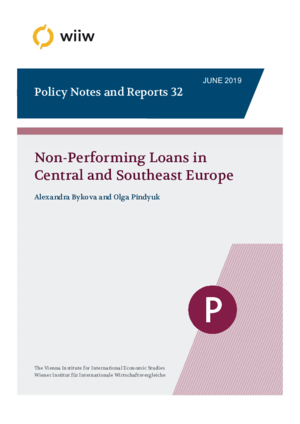Non-Performing Loans in Central and Southeast Europe
Alexandra Bykova and Olga Pindyuk
wiiw Policy Note/Policy Report No. 32, June 2019
29 pages including 6 Tables and 9 Figures
Exploring the determinants of credit risk has gained importance in the aftermath of the global financial crisis, which caused a sharp increase in non-performing loans (NPLs) in Central, East and Southeast Europe. In this note we first analyse the post-crisis trends in NPLs comparing five Southeast European countries with their peers in Central and Eastern Europe. Second, we estimate the effect of key macroeconomic drivers on NPL development in the region. We distinguish between total household loans, non-secured consumer loans, housing loans and loans to non-financial corporations, and investigate separately their corresponding determinants.
On average across the five Southeast European countries examined (Bosnia and Herzegovina, Croatia, Montenegro, Serbia, and Slovenia), after the crisis asset quality of corporate loans deteriorated more strongly than that of household loans. We find that GDP growth has a negative and statistically significant impact on NPLs for all types of loans. However, the impact on corporate loan quality is much greater than for households, and in particular for consumer loans (housing loans’ NPLs show a stronger negative relationship with GDP growth). We therefore conclude that the consumer loan quality is less susceptible to the business cycle than either corporate or housing lending. One possible explanation for this is that the amounts involved are smaller, and can often be serviced in times of difficulty by friends or relatives. This probably included relatives living abroad, given that outward migration from the Western Balkans is so high, and remittances inflows so large.
We find that various other macroeconomic indicators have an impact on asset quality. Rises in consumer and producer price inflation are associated with higher NPL ratios for all types of loans, but changes in real interest rates affect corporates more than households. This may be because corporates have a greater share of floating rate loans. Interestingly, higher unemployment also appears to affect corporate asset quality more strongly than that of households: this may again be related to the possibility of friends or relatives helping out with loan repayments for smaller consumer loans. Finally, we also find that periods of elevated loan growth are followed eventually by higher NPL levels.
Keywords: Southeast Europe, non-performing loans, credit cycle, financial crisis, unsecured household loans
JEL classification: G01, G21
Countries covered: CEE, SEE
Research Areas: Sectoral studies
